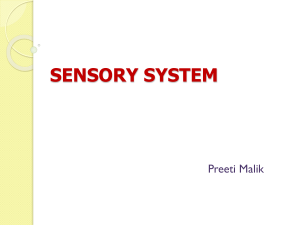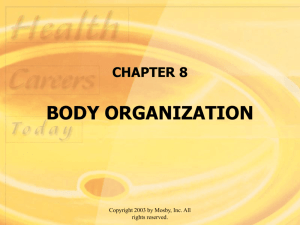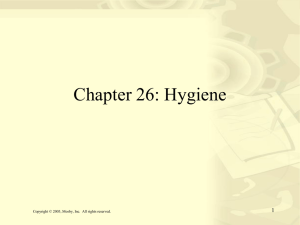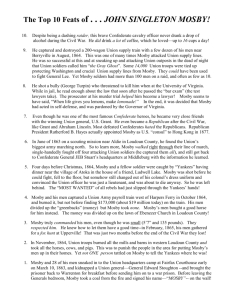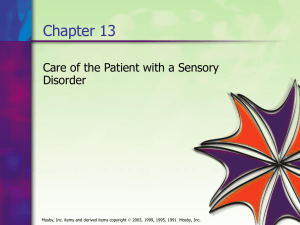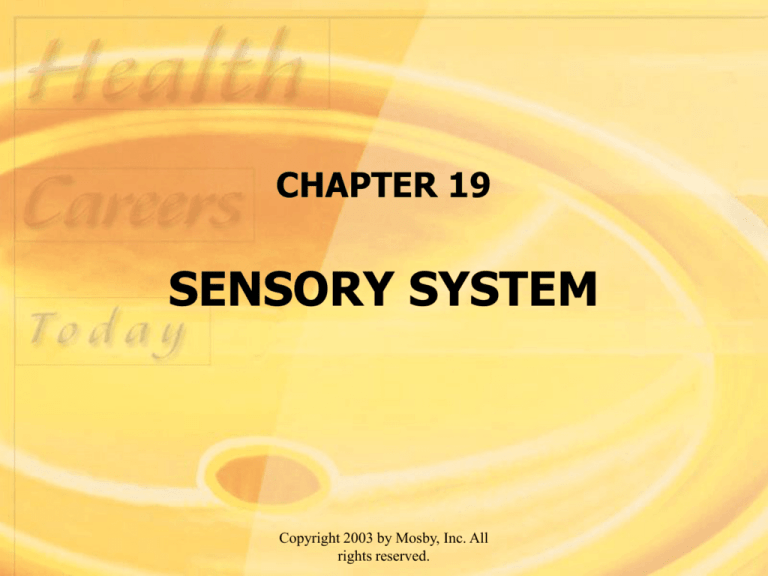
CHAPTER 19
SENSORY SYSTEM
Copyright 2003 by Mosby, Inc. All
rights reserved.
Structure and Function
• Sensory system consists of receptors in
specialized cells and organs that perceive
changes in the internal and external
environment
• The stimuli cause nerve impulses that are
sent to the brain for interpretation
• Environmental stimuli are perceived with the
senses of vision, hearing, touch, taste,
position, and balance
Copyright 2003 by Mosby, Inc. All
rights reserved.
Eye
• The most important sensory organ
because 90% of the information about
the environment reaches the brain from
the eyes
• Movement of the eye is controlled by
the extrinsic muscles
• Only one fifth of the eye is actually
exposed to the environment
Copyright 2003 by Mosby, Inc. All
rights reserved.
Figure 19-1 Structures of the
Eye
Copyright 2003 by Mosby, Inc. All
rights reserved.
Ear
• Auditory or acoustic sense (hearing) is
the primary function of the ear
• Helps maintain equilibrium
• Three parts of the ear
– External
– Middle
– Inner
Copyright 2003 by Mosby, Inc. All
rights reserved.
Figure 19-3 Structures of the Ear
Copyright 2003 by Mosby, Inc. All
rights reserved.
Tongue
• Taste, or the gustatory sense, is
perceived by specialized cells located in
papillae on the tongue called taste buds
• Flavor is identified by smell as well as
taste
Copyright 2003 by Mosby, Inc. All
rights reserved.
Nose
• Olfactory sense originates in olfactory
receptor cells in the nose that immediately
transmit impulses to the brain through the
olfactory cranial nerves
• Nasal cavity is divided into two sections by
the septum
• Olfactory receptor neurons are stimulated by
chemicals (gases) in the air
• Smells can reduce stress, affect blood
pressure, recall memories, and aid in the
sense of taste
Copyright 2003 by Mosby, Inc. All
rights reserved.
Figure 19-5 Nose and
Surrounding Structures
Copyright 2003 by Mosby, Inc. All
rights reserved.
Skin
• Senses of the skin perceive touch, pressure,
temperature, and pain through five
specialized cells located in the skin
–
–
–
–
–
Meissner's corpuscles
Pacinian corpuscles
End-bulbs of Krause
Corpuscles of Ruffini
Nociceptors
Copyright 2003 by Mosby, Inc. All
rights reserved.
Assessment Techniques
• Sight
–
–
–
–
Ophthalmoscope
Visual acuity
Tonometer
Color blindness chart
• Hearing
–
–
–
–
Otoscope
Impedance testing
Rinne’s test
Weber's test
Copyright 2003 by Mosby, Inc. All
rights reserved.
Disorders of the Sensory
System
• Achromatism
– Called color blindness, is a common inherited
defect
• Amblyopia
– Also called “lazy eye,” is poor vision in one eye
often resulting from better vision in the other eye
during infancy or early childhood
• Anacusis
– Hearing loss resulting from damage to neural
tissues
Copyright 2003 by Mosby, Inc. All
rights reserved.
Disorders of the Sensory System
(continued)
• Astigmatism
– A congenital defect causing imperfect curvature of
the cornea resulting in blurred vision
• Cataract
– Clouding of the lens that causes blurred or partial
vision
• Conjunctivitis
– Also called pink eye, is a bacterial or viral
inflammation of the eyelid
Copyright 2003 by Mosby, Inc. All
rights reserved.
Disorders of the Sensory System
(continued)
• Diabetic retinopathy
– Condition of damaged blood vessels in the retina
caused by uncontrolled diabetes mellitus
• Diplopia
– Or double vision, results from muscle imbalance or
paralysis of an extraocular muscle
• Epistaxis
– Nosebleed resulting from disease, trauma, or
other conditions such as hypertension, leukemia,
or rheumatic fever
Copyright 2003 by Mosby, Inc. All
rights reserved.
Disorders of the Sensory System
(continued)
• Glaucoma
– An increase in the pressure inside the eye, caused
by trauma or hereditary factors
• Hyperopia
– Farsightedness resulting from a congenital
deformity in the eye
• Macular degeneration
– A slow or sudden painless loss of central vision
Copyright 2003 by Mosby, Inc. All
rights reserved.
Disorders of the Sensory System
(continued)
• Meniere’s disease
– A collection of fluid in the labyrinth of the ear
leading to dizziness, ringing in the ear or tinnitus,
pressure, and eventual deafness
• Myopia
– Nearsightedness resulting from a congenital
deformity in the eye
• Night blindness
– Poor vision in dim light that results from a
deficiency in the rods of the retina
Copyright 2003 by Mosby, Inc. All
rights reserved.
Disorders of the Sensory System
(continued)
• Otitis media
– A middle ear bacterial or viral infection common in
young children
• Presbyopia
– A type of farsightedness related to aging
• Retinal detachment
– Due to injury or uncontrolled diabetes mellitus
Copyright 2003 by Mosby, Inc. All
rights reserved.
Disorders of the Sensory System
(continued)
• Rhinitis
– Inflammation of the lining of the nose caused by
allergic reaction, viral infection, sinusitis, or
chemical irritants
• Ruptured eardrum
– Results from infection, an explosion, a blow to the
head, or a sharp object inserted into the ear
• Sinusitis
– A chronic or acute inflammation of the cranium
Copyright 2003 by Mosby, Inc. All
rights reserved.
Disorders of the Sensory System
(continued)
• Strabismus
– A condition in which both eyes do not focus on the
same point or direction
• Stye
– Bacterial infection of the sebaceous glands of the
eyelid
Copyright 2003 by Mosby, Inc. All
rights reserved.
Issues and Innovations
• Visual correction by surgery
– Radial keratotomy
– Epikeratophakia
– Photorefractive keratectomy (laser surgery)
• Noise pollution
– Inner ear damage is permanent
– Loud music and phones can cause hearing
loss
Copyright 2003 by Mosby, Inc. All
rights reserved.

